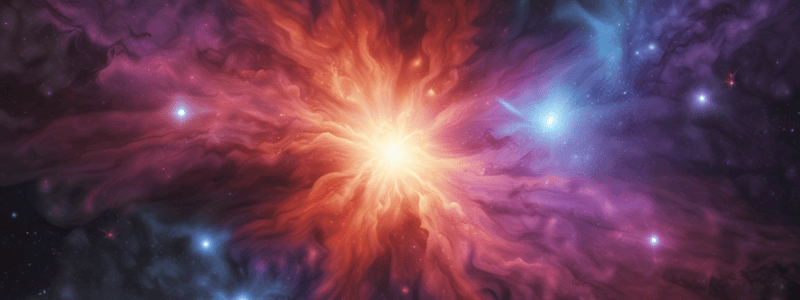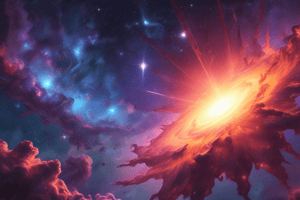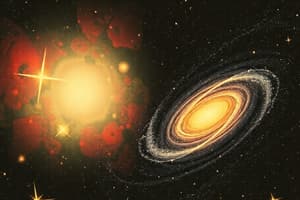Podcast
Questions and Answers
What initiates the formation of a star?
What initiates the formation of a star?
- The cooling of existing celestial objects
- The destruction of nearby stars
- The collapse of massive clouds of gas and dust (correct)
- Gravitational influence causing gas to expand
What defines the transition from a protostar to a main sequence star?
What defines the transition from a protostar to a main sequence star?
- The protostar temperature equalizes with the surrounding space
- Nuclear fusion begins in the core of the protostar (correct)
- The protostar is surrounded by a larger nebula
- The gravitational pull is stronger than nuclear forces
What is primarily the consequence if a protostar fails to accumulate enough gas?
What is primarily the consequence if a protostar fails to accumulate enough gas?
- It remains a stellar nebula
- It transforms into a hypernova
- It becomes a brown dwarf (correct)
- It becomes a red giant
What characterizes a T-Tauri star?
What characterizes a T-Tauri star?
What happens to a brown dwarf once its gas source is exhausted?
What happens to a brown dwarf once its gas source is exhausted?
How does the mass of a brown dwarf compare to that of stars and planets?
How does the mass of a brown dwarf compare to that of stars and planets?
What process do main sequence stars primarily use to burn their fuel?
What process do main sequence stars primarily use to burn their fuel?
What determines the lifespan of a giant star compared to a non-giant star?
What determines the lifespan of a giant star compared to a non-giant star?
What happens to a star after it exhausts its hydrogen fuel during the main sequence phase?
What happens to a star after it exhausts its hydrogen fuel during the main sequence phase?
What event occurs when a massive star reaches iron production in its core?
What event occurs when a massive star reaches iron production in its core?
What is the final stage of a star that was once a non-giant star?
What is the final stage of a star that was once a non-giant star?
How does the life expectancy of a red dwarf compare to that of the sun?
How does the life expectancy of a red dwarf compare to that of the sun?
What is the primary consequence of a supernova explosion?
What is the primary consequence of a supernova explosion?
Which type of star is formed from a star with a mass greater than 20 times that of the sun?
Which type of star is formed from a star with a mass greater than 20 times that of the sun?
What is a defining characteristic of a neutron star?
What is a defining characteristic of a neutron star?
What elements primarily make up the oldest stars?
What elements primarily make up the oldest stars?
What type of nebula is known for being the birthplace of multiple stars?
What type of nebula is known for being the birthplace of multiple stars?
What happens to matter that enters a black hole?
What happens to matter that enters a black hole?
Which nebula was formed from a supernova and is known for its size?
Which nebula was formed from a supernova and is known for its size?
What is a protostar?
What is a protostar?
Flashcards are hidden until you start studying
Study Notes
Star Formation
- Star formation is the universe's oldest process, initiated by the gravitational collapse of massive gas and dust clouds known as stellar nebulas.
- The initial stage is the protostar, a sphere of gas undergoing compression, generating significant heat and pressure; surrounded by a disk of dust and gas.
- Nuclear fusion marks the transition from protostar to main sequence phase, occurring when gravity can no longer compress the protostar and fusion of hydrogen into helium begins.
- If a protostar fails to commence nuclear fusion, it becomes a brown dwarf, falling between planet and star categories.
Brown Dwarf
- A brown dwarf has a mass between approximately 12 to 18 Jupiter masses but cannot sustain nuclear fusion due to insufficient gas accumulation.
- They cool down over time, classified as failed stars due to early exhaustion of gas supply.
T-Tauri Stars
- T-Tauri stars are early main sequence stars under 10 million years old, signifying the transition just after the protostar phase.
Main Sequence Stars
- Main sequence is the predominant life stage where stars burn hydrogen through nuclear fusion; the majority of their life is spent here.
- Lifespans vary dramatically: red dwarfs can exist for up to 1 trillion years, while giant stars may only last 10 to 100 million years.
- The Sun, an average-sized star, has an estimated life expectancy of around 10 billion years.
Stellar Evolution
- Once hydrogen is depleted, stars contract and begin to fuse helium along with heavier elements, culminating in rising internal pressure that leads to additional swelling into red giants.
- During this phase, outer layers eventually detach, forming a planetary nebula; the remnant core is labeled a white dwarf.
White Dwarfs
- White dwarfs are the dense remnants of non-giant stars, gradually cooling into black dwarfs, though none exist currently due to the prolonged nature of this process.
Giants and Supergiants
- Giant stars possess at least eight times the mass of the Sun, burning fuel at an accelerated rate.
- Supergiants, much larger than typical giants, undergo rapid fusion until they generate iron and subsequently experience catastrophic supernova explosions.
Neutron Stars and Black Holes
- Post-supernova, stars between 8-19 solar masses become neutron stars, incredibly dense remnants, while those 20 solar masses or more collapse into black holes, points of infinitely compressed matter.
Composition of Stars
- Stars primarily consist of hydrogen and helium; older stars exhibit higher concentrations of these elements whereas younger stars contain heavier metals.
- Nebulas, where both star formation and post-mortem star remnants reside, exist as massive gas and dust clouds.
Types of Nebulas
- Stellar nebulas are massive enough to form multiple stars and are rich in hydrogen; “The Pillars of Creation” is a prominent example creating thousands of stars.
- Planetary nebulas, often resulting from star death, can span light-years and produce various visual appearances based on their progenitor star's mass.
Protostars
- Protostars result from gas collapse within a nebula and are in a state of gravitational compression; fusion has yet to occur.
- A protostar will only become a star if nuclear fusion initiates before it exhausts its material; otherwise, it will develop into a brown dwarf.
Studying That Suits You
Use AI to generate personalized quizzes and flashcards to suit your learning preferences.




